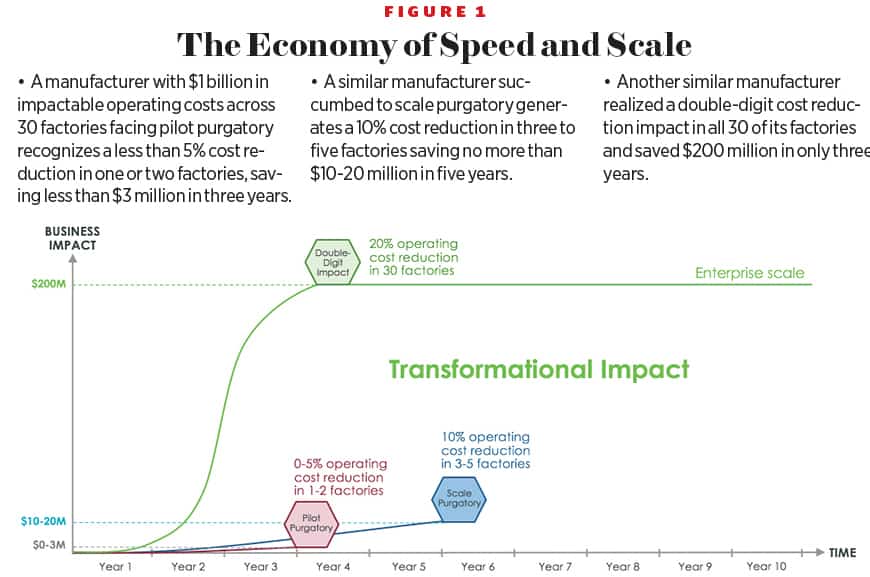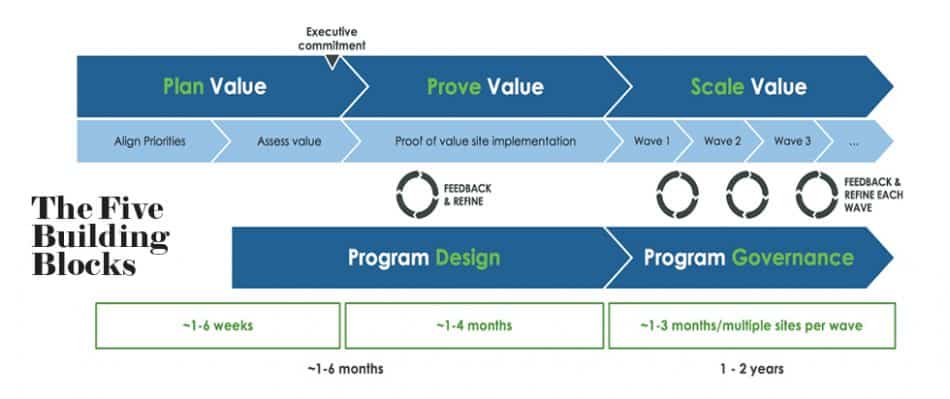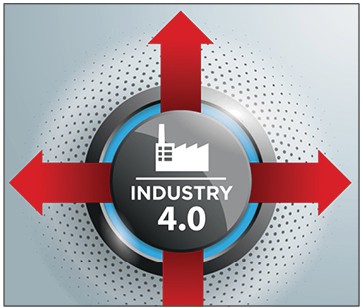
Pilot and scale purgatory are two problems that limit manufacturers from realizing the benefits of I4.0. Here’s a five-step plan to overcome the obstacles.
By Craig Melrose, Barry Lynch, Howard Heppelmann, James Zhang, and David Immerman.

Digital Transformation (DX) and Industry 4.0 (I4.0) programs are on most CxOs’ top strategic planning lists. Ninety percent of industrial companies are investing in digital factories and over 70% consider Digital Manufacturing at the top of their operations strategy agenda. However, many fail to achieve the necessary impact, speed, and scale that delivers double-digit business value. The question is why?1
Significant challenges exist for implementing these programs across business functions, physical sites, and global personnel. Both the magnitude to scale programs across the organization and the speed to do it within a business cycle present obstacles, yet tangible opportunities exist for those who preemptively plan to overcome them.
We’ve had the benefit of working with hundreds of leaders on some of the most successful I4.0 transformations. We’ve uncovered two obstacles that limit most industrial companies from capitalizing on the benefits of I4.0: pilot purgatory and scale purgatory. When programs fail to deliver meaningful financial impact via speed at scale, they lose enterprise-level sponsorship and support needed to succeed.
Pilot purgatory: Many manufacturers struggle with timely and efficient scaling of pilot projects into production. The majority of stalled initiatives share a common theme – technology, rather than financial impact, is mistakenly the focus of the transformation program. This manifests in two ways: prioritization of technology-oriented use cases focused on non-constraint areas and the pursuit of too many parallel use cases leading to fragmentation. Manufacturers on average start with eight digital pilot projects and 75% of these fail to scale. 2These manufacturers often spend two to three years in pilot purgatory and fail to prove solid business value. That’s why companies are set back and the organization, especially CxOs, loses interest in the pursuit of transformation because transformation impact is not visible.
Scale purgatory: Manufacturers are increasingly challenged with duplicating success past their inaugural implementations. While pilot purgatory prevents companies from moving from pilot to production, scale purgatory inhibits companies from rapidly capitalizing on pilots that could deliver transformational outcomes if they were scaled across the production network in a timely manner. Without intention or knowing, it will take many manufacturers five to 10 years to capture desired impact at scale. This is a failed recipe for leveraging digital as a transformational opportunity. Pockets of value may be created but a lack of enterprise impact is almost certain to result in the condemnation of these initiatives to tactical levels of the organization where C-level focus shifts to other priorities.

Manufacturers who have surrendered to scale purgatory haven’t achieved the potential of speed and capacity at scale to unlock the full double-digit potential value at the full enterprise level.
Our experience from our clients has brought light into an economic model which is applied to compare the difference between tactical value and transformational value that typical manufacturing companies with $1B impactable operating cost can unlock.
The companies that unlock transformational value with speed and scale across the production network potentially can realize ten times or even one hundred times more financial impact than those that are stuck in pilot purgatory or scale purgatory.
5 Building Blocks
Manufacturers must form their I4.0 program with these two obstacles in mind and consult these five building blocks for successful transformations:
- Plan value to align to business strategy
- Program Design to get organization, people, processes and technologies orchestrated
- Prove Value to illustrate real-world impact
- Scale Value to create transformative waves
- Program Governance to ensure ongoing and future success.
These phases typically are synchronized and coordinated with one another and although the timeline may differ, the usual sequential path to success begins with plan value, design a program to prove this value, and, ultimately, scale and govern it.
1. Plan Value
Planning value starts by aligning with the company’s business goals and challenges. Usually at this stage, manufacturers map out what financial driver is the top priority, what operational initiatives drive financial impact, and what use case and technologies enable and enhance the operational initiatives.
There are typically mismatches between the C-suite’s P&L-prioritized mindset and operational teams focused on factory metrics. During the Plan Value stage, a key outcome is mapping P&L with operational metrics and digital use cases. Once use cases are prioritized, a strong business case and transformation roadmap are developed. The whole organization, ranging from the C-suite to plant managers, must align and commit to the transformation program.
a. Secure Executive Commitment
In the path to achieve double-digit I4.0 impact at scale3, the importance of taking a financial impact-first approach to align with executives is critical. Illustrating the attainable value on key financial KPIs for CxOs is crucial to secure initial buy-in and ongoing program commitment. I4.0 programs that increase revenue, improve asset efficiency, and/or reduce operating costs drive this top-down organizational shift.
The Digital Transformation Officer (DXO) plays a key role in securing and maintaining this business alignment, and, once secured, additional detail-oriented conversations to plan value must occur. The two primary segments to planning value for financial improvements are identifying the what and planning the how.
In other words, prioritize what use case will provide the most value in the shortest amount of time and how to adopt the specific use case or cases as seamlessly as possible.

b. Impact-Driven Use Case Prioritization
Every organization is different and must contemplate unique parameters across drivers and resource factors. The manufacturer’s drivers could be connected to its strategy of high volume requiring high levels of throughput, common with a process manufacturer of pharmaceuticals. It could be high quality and customized automobiles, which challenge the automaker’s flexibility, agility, and resiliency.
Qualifying time-to-value for I4.0 programs must answer questions on the resources and digital maturity required to complete any brownfield integrations, the plant or asset downtime for implementing the digital solution, the internal skillset, and external resources and partners at-hand to install the first use case and manage future ones.
Dozens of use cases can be identified, but those that have the greatest impact and fastest time to value should be on the shortlist. For many manufacturers, this initial use case will target the selected facility’s largest production bottleneck.
2. Program Design
I4.0 is a journey to change the way of working in factories. While it is enabled by technologies, people will always be needed to unlock its value.
a. Core Team Planning and Organizational Structure
The traditional organizational structure of information technology (IT) and operational technology (OT) teams have the two operating in silos. IT has typically been responsible for managing compute resources and workloads from the myriad OT execution venues and is viewed more as a cost center then as an innovation hub. OT has been seen as engineering-driven personnel with factory domain expertise, but guilty of one-off project sprints without the manufacturer’s total operational capacity and strategy in mind.
I4.0 programs expose the need for coordination, collaboration, and, ultimately, convergence of IT and OT. The companies that include operations stakeholders in their transformation team (59%) are five times more likely to have successfully implemented their transformation program than to be stuck in pilot purgatory.
Many organizations have formally established a digital transformation team, which is a combination of IT, OT, and operations. The DXO typically heads-up this team that transcends silos existing between internal departments and divisions, focuses on the highest value use cases, and serves as the company change agent for I4.0.
Some simple shifts in roles and responsibilities across departments may be needed to form centers of excellence (CoE), which can also spur I4.0 transformation. These CoEs represent different organizational functions; they share ideas, create resources, and work with external partners. The implementation of digital projects requires a unique mix of skillsets with some roles already prevalent in industrial plants and others in their nascence. Sourcing this expertise will require coordination with a broader partner ecosystem inclusive of technology providers, systems integrators, and advisory firms.
Enacting executive commitment early in I4.0 can create this organizational alignment, related project success, and fuel future change.

b. Formalize a Technology and Service Ecosystem
Putting the pieces in place extends past people organizational structure planning with formalizing the right technology ecosystem. Technology vendors who are business outcome-driven and view I4.0 as a digital journey and not a point-in-time transaction are more likely to drive double-digit impacts for industrial companies. Vendors with partnership tie-ins and strategic alliances create an ecosystem to accelerate I4.0 journeys. Guidance through the complexity of industrial technologies, knowledge of business processes and worker adoption best practices, and domain expertise and experience of implementing digital capabilities in factories are key components in evaluating technology ecosystems. Thinking of I4.0 as a technology-driven ecosystem rather than a one-off vendor engagement will greatly speed up transformation at scale.
c. Create an Enterprise Program Playbook
Most have realized the need to synchronize IT and OT, but have trouble formalizing what tangible action items to take to expedite I4.0. The goal should be to leverage an initial successful use case to establish a repeatable process to scale to other sites. We’ve seen this goal come into fruition more often when I4.0 and DX teams create an enterprise program playbook.
A playbook provides a recipe to adopt the prioritized use case in a subsequent factory, site, or other location. It includes learning resources such as roadmaps, best practices, program governance models, enterprise architectures, user roles and responsibilities, and organizational change and communication strategies. Leveraging this knowledge base empowers site leaders to seamlessly adopt the use case in their facility.
CASE STUDY: How Pfizer Scaled to 5 Sites in 18 Months
Pfizer is a major pharmaceutical manufacturer with more than 88,000 employees and 42 production sites worldwide. Faced with skills gap and workflow complexity concerns, Pfizer prioritized its I4.0 program around improving its manufacturing workers methods for learning, working, and utilizing information to drive shop-floor efficiencies.
The manufacturer created a Digital Manufacturing team to propel this I4.0 program and roll out an ”Expert Capture” use case to provide task guidance through captured knowledge content. To scale the use case across its many sites, the team created a knowledgebase – a playbook with any information its site lead would want to know to implement the use case.
This knowledgebase propelled Pfizer to rollout 12 solutions across fives sites in 18 months. Pfizer will continue to track recognized value, document metrics, and update the playback based on program feedback to foster future success.
3. Prove Value
With the program designed and the organization committed, the next critical stage is to prove the value in the selected site. The key at this stage is to validate the impact model built in the plan value stage and the playbook built in the program design stage. Depending on the complexity of the use case, it might take one to three months to implement the solution in the selected site and production line. Additional weeks must be allocated for factory workers and managers to adopt the solution and change their ways of working.
The program will need to implement a benchmark that quantifies value and measures the KPI improvements from the use case. Once value and results are determined, program sponsors must communicate these early successes and lessons learned to key stakeholders and executive sponsors.

Companies that include operational stakeholders in their transformation team are five times more likely to have a successful transformation program.
CASE STUDY: Pactiv’s Program Enables Rapid Scaling
Pactiv is a food packing manufacturer with more than 50 production plants globally. It was challenged with how to increase OEE and production capacity to avoid capex and increase recurring EBIDTA. Pactiv formed a Digital Manufacturing Transformation program that created three use cases – performance monitoring, factory asset intelligence (FAI), and Fully-enabled Smart Factory.
Pactiv prioritized these use cases on a factory-by-factory basis based on bottlenecks. Performance monitoring is the lowest cost, effort, and benefits solution Pactiv offers its sites, while Smart Factory is the high-end, resource intensive, full factory transformation. While Pactiv deemed some factories needed this end-to-end connectivity and some reached OEE improvements of 10%, most fit into its FAI solution.
FAI standardized components of the production process that are targeted at factory-specific problems such as high downtime costs. This value-driven program quickly proved its worth with improvements in factory-specific key metrics such as a 50% decrease in downtime from material issues in one an 11% decrease in downtime from equipment failures in another.
The manufacturer’s proof-of-value program with on-site surveys, baseline assignments, and project planning with 12-36 development sprints is putting it on pace to rapidly scale to dozens of sites in months. 6
4. Scale Value
With value planned and proven, manufacturers will quickly duplicate the use case to subsequent sites and roll out multiple use cases. At this stage, teams will streamline and execute parallel implementations while continuously refining and optimizing the program’s design. Additional technology considerations, such as the formation of an enterprise architecture, will come into play to make this speed and scaling vision a reality.
a. Agile Methods and Parallel Activities
Manufacturers need to start thinking of I4.0 in agile software development terms: quick sprints with targeted goals using cross-functional collaborative teams to generate powerful outcomes.
The key component of agile and scrum methods is rapid two- to four-week sprints where the most pressing developments are made. This can take the form of Minimum Viable Products (MVPs), which provide the basic functionality to resolve a problem and a benchmark to build from. 7
Building a table stakes use case that creates some value is more impactful then spending months or years on a fully polished product or multiple use cases. It is critical, however, that any MVP is still developed with an enterprise architecture for scalability and not as a one-off solution. A good MVP deployment will start to uncover some of the initial business benefits and simultaneously be a robust, production-hardened enterprise platform. This is then used to maximize the value from the initial use case and build upon for the consequent use cases.

A governance model formed by a steering committee can
prioritize tasks and ensure alignment and accountability.
Establishing parallel activities expands past agile development methods for scaling I4.0. Bringing in subsequent site leads or champions from other facilities early into the use case roll-out process can greatly expedite adoption of their own. Setting a collaborative environment for these site leads to share resources and ideas enables rapid success.
Like agile, these enterprise rollouts need to be viewed as short-targeted sprints with parallel activities creating waves of transformation and replacing traditional sequential processes.
b. Enterprise Architecture Supports Scaling
Forming an enterprise architecture as the technological backbone to support scaling is a critical I4.0 consideration. It is unreasonable to expect GMs to make massive technological overhauls and investments in their facilities. This places an emphasis on pre-built solutions that can be seamlessly integrated and scaled across multiple sites.
The cloud’s scalable infrastructure increasingly places it on the roadmap for I4.0 projects and 58% of industrial companies agree.8
Inevitably, the prioritized use case will develop past the minimum viable product in functionality and complexity, and the cloud is more accustomed to handling a sophisticated workload across sites, users, and use cases.
The flexibility of the technology platform is integral to developing pre-built applications that scale across multiple sites. Industrial Internet of Things (IIoT) platforms are at the heart of many I4.0 use cases, providing a means to quickly develop, manage, and analyze mission-critical applications on the factory floor. These platforms’ flexibility is essential to connect myriad industrial data sources and systems in heterogenous environments; manage the thousands of assets, production lines, and factories in these environments; and increasingly run powerful real-time analytics for unprecedented operational visibility and actionable insights.
CASE STUDY: Carlsberg Leverages Agile Methods
Carlsberg is a global brewer with around 100 production facilities annually producing 12 billion liters of beer. The process manufacturer needed operational transparency and end-to-end visibility across its many different sites, floors, and equipment to drive efficiencies and agility.
With its entire operations in purview, Carlsberg implemented a I4.0 program designed to rapidly scale across dozens of sites. Carlsberg created a flexible Digital Manufacturing Solution with agile development methods and enterprise architecture inclusive of a cloud infrastructure and IIoT platform. 9
The manufacturer quickly scaled its real-time production management solution across more than 20 breweries in two years and plans to roll it out to additional facilities in the near future.
5. Program Governance
Managing multiple parallel deployments is key to delivering high levels of time-to-value and achieving speed. A governance model formed by a steering committee prioritizes tasks and ensures alignment and accountability for meeting the growth plan with a charter of the current use case and preparation for future ones.
This committee of key internal stakeholders (corporate/regional leadership) and external partners and vendors provides a dynamic team to quickly adjust to business challenges and industry headwinds. Leveraging a surround and extend strategy enables the committee and company to evolve with shifting market conditions to ensure its I4.0 program makes the best decision that quickly extends the value of the deployment.
Every organization is at a different point in their I4.0 journey. Companies just getting started should rethink their initial use cases with a financial-first impact mindset and a critical constraint focus while others further along improve and formalize programs to achieve value at speed and scale. The idea of initiating change for the next year to achieve better financial standing for the following three years and beyond is applicable to any company. Following these I4.0 principles can unlock a better tomorrow for manufacturers who need to change today. M
1 Digital Manufacturing – escaping pilot purgatory https://www.mckinsey.com/~/media/mckinsey/business%20functions/operations/our%20insights/how%20digital%20manufacturing%20can%20escape%20pilot%20purgatory/digital-manufacturing-escaping-pilot-purgatory.pdf
2 ‘Digital Manufacturing – escaping pilot purgatory’ https://www.mckinsey.com/~/media/mckinsey/business%20functions/operations/our%20insights/how%20digital%20manufacturing%20can%20escape%20pilot%20purgatory/digital-manufacturing-escaping-pilot-purgatory.pdf
3 ‘Finally, Double-Digit I4.0 Impact at Scale’ https://www.manufacturingleadershipcouncil.com/2020/02/11/finally-double-digit-i4-0-impact-at-scale/
4 ‘The #1 Reason Your Industrial Transformation Will Fail’ https://blog.lnsresearch.com/the-1-reason-your-industrial-transformation-will-fail
5 ‘THE EFFECTIVE IMPLEMENTATION OF SOPS USING AUGMENTED EXPERT GUIDANCE’ https://archive.liveworx.com/sessions/the-effective-implementation-of-sops-using-augmented-expert-guidance#presentation
6 https://protect-us.mimecast.com/s/5oVnC73MzKFA9E10u8qn71?domain=ptc.com” https://www.ptc.com/en/resources/manufacturing/webcast/iiot-increases-equipment-efficiency
7 Upgrading your business to a digital operating system’ https://www.mckinsey.com/~/media/McKinsey/Business%20Functions/McKinsey%20Digital/Our%20Insights/Upgrading%20your%20business%20to%20a%20digital%20operating%20system/Upgrading-your-business-to-a-digital-operating-system.ashx
8 ‘The State of Digital Transformation’ https://www.ptc.com/en/resources/iiot/white-paper/state-of-industrial-digital-transformation
9 ‘PTC and Microsoft: Accelerating Digital Transformation for Industrial Enterprises’ https://www.ptc.com/en/resources/iiot/webcast/ptc-and-microsoft